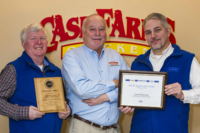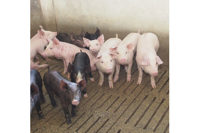“It was the growth of our business in several areas that led us to accomplish that,” says Gary Malenke, chief executive officer of the Sioux Center, Iowa, company. Along with longer operations hours and some Saturday production, one of the biggest boosts for the company was its export sales.
“We saw tremendous demands for the export of pork, and we were able to take advantage of the really strong demand in that sector,” he says.
Humane handling
With the increased output the company has seen, one thing that has not changed is Sioux-Preme’s attention to animal handling. In 2007, the company installed a new atmospheric stunning system in its harvest plant in Sioux Center. Malenke notes there had been an increased demand from customers looking for higher levels of animal welfare.“It really was a natural for us to be on the front edge of that curve,” he says.
Along with the change from electrical to gas stunning, the new system doesn’t require animal handlers to force the animals into a single-file line.
“Pigs don’t naturally go single file,” Malenke says. “Consequently, it creates a higher-stress environment with the traditional methods of stunning to get them single filed. With the CO2 system, they’re able to walk two or three animals side by side, and it’s a much lower-stress situation.”
As a result, the raw pork that Sioux-Preme produced is darker in color than pork from electrically stunned pigs, and the meat has a higher pH level, which allows it to retain moisture better.
Malenke says the incident of animal abuse that occurred last year in the Westland/Hallmark plant in Chino, Calif., overflowed from the beef sector into the pork side of the business as well. Customers have become more aware of animal handling issues, and the USDA has also increased its surveillance of livestock handling. There is also the issue of activist organizations like PETA and the Humane Society of the United States. Malenke notes that those organizations weren’t really on the radar even 10 years ago.
“Today, there’s probably not a business out there on the side of harvesting live animals that doesn’t have a level of awareness or concern,” he says. Sioux-Preme had been aware of the trend for several years before the Hallmark incident, and it built a new live hog facility in 2004 to prepare for it.
“We needed to eliminate 90-degree corners, we needed to eliminate slippery floors,” Malenke says. “We needed to [change] the way we moved livestock.”
The company uses plastic paddles with BBs inside them to move the animals less aggressively. The facility is also fully ventilated and heated, with water in every pen and a mister system that helps keep the pigs cool in the summer.
Having the safeguards for the animals is one thing, but Sioux-Preme also audits itself on a regular basis, on top of the regular third-party audits the company undertakes.
“We keep weekly logs and analyze animal-handling practices to monitor ourselves,” Malenke says.



Report Abusive Comment